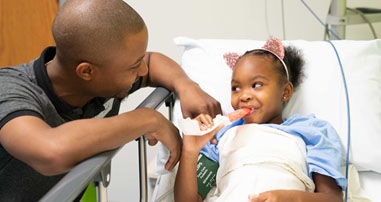Targeted Muscle Reinnervation (TMR)
Targeted muscle reinnervation (TMR) is a special type of surgery used for limb amputations. The surgery changes the placement of nerves in the amputated limb, helping with pain your child may feel as a result of the amputated limb, including phantom pain after an amputation. TMR also provides increased muscle activity that can help power special types of prosthesis.
Why do some patients need TMR after an amputation?
- Pain linked to amputations is both common and challenging.
- The amputated limb often contains painful neuromas, sometimes described as burning, aching or electric-shock sensation, as the limb heals. This can cause both pain in the limb and phantom pain as well.
- For some children (and adults) with upper limb amputations, the choice of prosthesis is limited by the number of working muscles and joints in the part of the limb that was not amputated. TMR expands the kinds of prosthetics someone can consider, including advanced electrical prosthetics.
Specialized care for your child
Our team is the only comprehensive pediatric TMR surgery program in the Southeast. Our specially-trained providers will create treatment and follow-up care plans specific to your child’s needs.
TMR works by re-wiring nerves in the amputated limb. There are two types of nerves that are cut during an amputation surgery:
- Motor nerves: These nerves are in the muscle and help move our muscles and bones.
- Sensory nerves: These nerves are in the skin and help us feel.
TMR puts the live nerve endings to work by attaching them to other nerves inside the remaining limb and preventing new neuromas. This gives the cut nerves something to grow into, and can create a foundation for advanced prostheses in some cases.
TMR may be performed at the time of the amputation (primary TMR) or sometime after the amputation (secondary TMR).
Before surgery, you will meet with your child’s surgery team. Ask any questions you or your child have. It may help to write down your questions before the visit, so you remember to ask them.
On the day of surgery, you will meet your anesthesiologist, nurses and surgeons. Your child will be able to go home when their discomfort is low enough for you to treat at home. Your surgery team will talk with you about your child’s hospital stay after the surgery.
After surgery, you can talk with your child’s care team about:
- How to care for your child’s incision where the surgery was done. This is called wound care.
- When to follow-up with the doctor.
- Work with pediatric physical therapists and prosthetists to help heal their remaining limb and prepare for prosthetic fitting and exercises that will lead to a more active life.
Contact Us 404-785-5684

